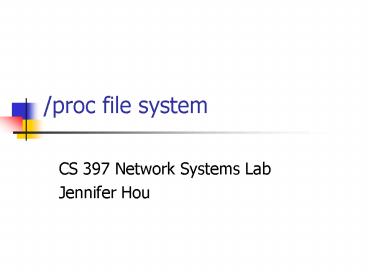proc file system PowerPoint PPT Presentation
1 / 9
Title: proc file system
1
/proc file system
- CS 397 Network Systems Lab
- Jennifer Hou
2
Overview
- The /proc file system (procfs)
- Is a special file system in the linux kernel.
- Is a virtual file system that is not associated
with a block device but exists only in memory. - allows programs in the user space to access to
certain information from the kernel.
3
/proc File System Entries
- To use any of the procfs functions, you have to
include the correct header file! include
ltlinux/proc_fs.hgt - struct proc_dir_entry create_proc_entry(const
char name, mode_t mode, struct proc_dir_entry
parent) - This function creates a regular file with the
name name, the mode mode in the directory parent.
- To create a file in the root of the procfs, use
NULL as parent parameter. - When successful, the function will return a
pointer to the freshly created struct
proc_dir_entry - foo_file create_proc_entry(foo, 0644,
example_dir)
4
Creating a Directory and a Symlink
- struct proc_dir_entry proc_mkdir(const char
name, struct proc_dir_entry parent) - Create a directory name in the procfs directory
parent. - struct proc_dir_entry proc_symlink(const char
name, struct proc_dir_entry parent, const char
dest) - This creates a symlink in the procfs directory
parent that points from name to dest. This
translates in userland to ln -s dest name.
5
Communication Between User Process Kernel
- procfs works with call back functions for files
functions that are called when a specific file is
being read or written. - Such functions have to be initialized by setting
the read_proc and/or write_proc fields in the
struct proc_dir_entry that the function
create_proc_entry returned - struct proc_dir_entry foo_file
- foo_file-gtread_proc proc_read_foobar
- foo_file-gtwrite_proc proc_write_foobar
6
Reading Data from Kernel
- int read_func(char page, char start, off_t
off, int count, int eof, void data) - The read function should write its information
into the page. - The function should start writing at an offset of
off in page and write at most count bytes. - eof should be used to signal that the end of the
file has been reached by writing 1 to the memory
location eof points to.
7
Writing Data into Kernel
- The write call back function allows a user
process to write data to the kernel. - int write_func(struct file file, const char
buffer, unsigned long count, void data) - It reads count bytes at maximum from the buffer.
- The buffer doesn't live in the kernel's memory
space, and should first be copied to kernel space
with copy_from_user. - The file parameter is usually ignored.
8
Reading Data from Kernel
- struct proc_dir_entry create_proc_read_entry(cons
t char name, mode_t mode, struct proc_dir_entry
parent, read_proc_t read_proc, void data) - This function creates a regular file in exactly
the same way as create_proc_entry, but also
allows to set the read function read_proc in one
call.
9
Removing an Entry
- void remove_proc_entry(const char name, struct
proc_dir_entry parent) - Removes the entry name in the directory parent
from the procfs. - Be sure to free the data entry from the struct
proc_dir_entry before remove_proc_entry is called

